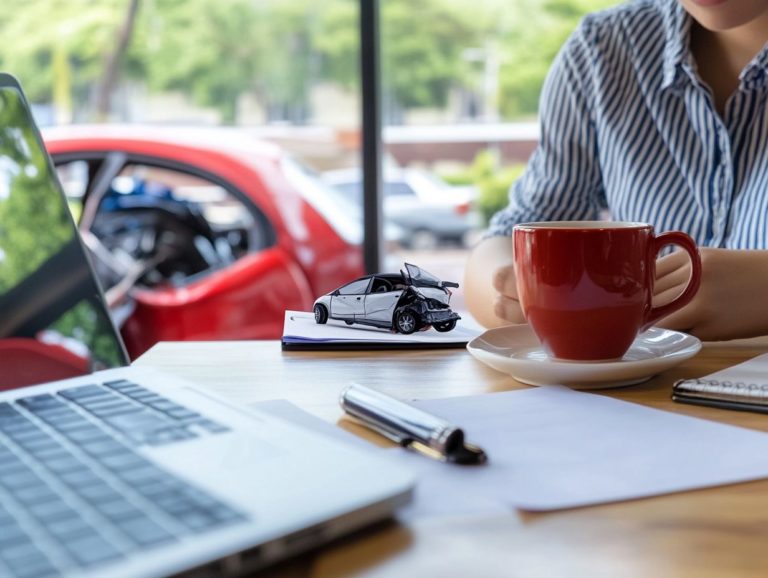Understanding Liability in Auto Insurance Claims
Auto insurance liability is an essential component of driving that every car owner must grasp. It offers financial protection in the unfortunate event of an accident, covering expenses related to bodily injury and property damage.
This article delves into the different types of auto insurance liability, explains how fault is assessed in accidents, and outlines crucial steps for filing a liability claim.
You ll find a detailed breakdown of policy limits and coverage options, empowering you to navigate the complexities of auto insurance with confidence.
Contents
- Key Takeaways:
- Overview of Auto Insurance Liability
- Types of Auto Insurance Liability
- Determining Fault in Auto Accidents
- Factors Considered in Fault Determination
- Filing a Liability Claim
- Limits and Coverage of Liability Insurance
- Frequently Asked Questions
- What is liability in auto insurance claims?
- How is liability determined in auto insurance claims?
- What is the difference between liability and full coverage in auto insurance?
- Do I need liability insurance if I am not at fault in an accident?
- Can I choose the amount of liability coverage in my auto insurance policy?
- Will my liability insurance cover me if I lend my car to someone else?
Key Takeaways:
- Understand liability to know who pays for damages.
- Bodily injury and property damage liability protect you from injuries and damages.
- Gather evidence and follow steps when filing a claim for proper coverage.
Overview of Auto Insurance Liability
Auto insurance liability is a vital part of vehicle ownership, providing you with financial protection should an accident occur. This coverage includes both bodily injury liability and property damage liability, safeguarding your interests and those of others involved in the incident.
Understanding liability car insurance helps you navigate minimum insurance requirements set by state laws. Knowing this helps you make smart choices regarding your auto insurance policy and anticipated premiums, ensuring you re protected on the road.
Types of Auto Insurance Liability
As a vehicle owner, it s crucial to be aware of the different types of auto insurance liability. Bodily injury liability and property damage liability are key components that provide essential financial protection against the risks associated with car accidents.
Understanding these coverages safeguards you in the event of an unforeseen incident.
Bodily Injury Liability
Bodily injury liability coverage is essential to your auto insurance. It handles medical expenses and other damages caused by an at-fault driver in an accident.
This coverage eases the immediate financial burden of hospital bills and rehabilitation costs, shielding you from potential legal fees if injured parties pursue lawsuits. With this protection, you can drive with greater confidence, knowing you re prepared for unforeseen expenses.
It s important to differentiate this from personal injury protection; while the latter covers your own medical expenses, bodily injury liability ensures you meet your responsibilities to others. Together, they create a robust safety net, providing peace of mind on the road.
Property Damage Liability
Property damage liability is vital in your liability car insurance. It covers costs associated with damage to another person’s vehicle or property when you’re at fault in an accident.
This coverage ensures that if an incident occurs, the financial responsibility for repairs or replacements won t land squarely on your shoulders, protecting you from hefty out-of-pocket expenses.
It’s important to have sufficient coverage limits, as repair costs can soar. The limits you choose influence your overall insurance premiums; while higher limits typically lead to increased premiums, they also offer you greater security against potential liabilities.
Determining Fault in Auto Accidents
Determining fault in auto accidents is critical. It impacts liability insurance claims and defines the financial responsibilities of the at-fault driver. This assessment shapes immediate consequences and has long-term implications, significantly influencing their insurance premium moving forward.
Factors Considered in Fault Determination
In the fault determination process following a car accident, several critical factors come into play. These include the actions of both drivers, road conditions, and adherence to state laws. Among these factors, traffic violations carry significant weight. Infractions such as running a red light or speeding can heavily sway the outcome.
Evidence gathered from the scene eyewitness accounts, surveillance footage, and police reports is carefully scrutinized to paint a clearer picture of what transpired. Insurance agents interpret these details and often rely on this evidence to determine liability, which means being responsible for damages or injuries caused in an accident, and decide on their next course of action.
The determination of fault is not merely an academic exercise; it can have profound implications. It influences not only the legal fees associated with pursuing claims but also the compensation that injured parties may receive. Ultimately, this affects their long-term financial recovery.
Filing a Liability Claim
Don t worry! Filing a liability claim can be simple if you follow these steps. It involves navigating the details of your auto insurance policy, adhering to coverage limits, and seeking counsel from an insurance agent.
This careful approach ensures that the entire process unfolds smoothly and efficiently.
Step-by-Step Process
The process for filing a liability claim begins with gathering all necessary documentation, such as accident reports, medical expenses, and insurance information to strengthen your case.
This initial collection of evidence is vital as it creates a clear picture of the incident and its aftermath. Next, you ll need to report the claim to your insurance provider. This usually involves filling out specific forms and attaching the documentation you’ve compiled.
This is where your insurance agent’s expertise comes in handy; they guide you through the complexities of the process, ensuring that all necessary information is accurately presented. After you submit everything, an adjuster will review the details.
Keep in mind that any discrepancies in your documentation could significantly impact the outcome of your claim. Therefore, being thorough is essential at every step.
Limits and Coverage of Liability Insurance
Understanding the details of liability insurance coverage is crucial for vehicle owners like you. It ensures you meet the minimum coverage requirements and secure the financial protection you desire in the unfortunate event of an accident.
Understanding Policy Limits
Understanding policy limits is essential for determining how much liability insurance will cover for damages and medical expenses in the event of an accident.
These limits are usually established based on various factors, including state requirements, your personal financial situation, and risk assessment. When you choose higher limits, you often gain increased financial protection, safeguarding your assets in the event of a significant claim. On the flip side, opting for lower limits might save you some money on premiums initially, but it could lead to substantial out-of-pocket expenses after an accident.
This choice directly impacts your overall financial security and peace of mind. It’s important to carefully evaluate your insurance needs and the potential liabilities you face.
Coverage for Different Types of Accidents
Different types of accidents necessitate specific coverage options, such as collision coverage and comprehensive insurance, which beautifully complement your basic liability insurance for enhanced protection.
Understanding how these various coverages work together is vital for securing your financial peace of mind. For example, in the event of a single-vehicle accident, collision coverage helps cover repair costs, allowing you to avoid relying solely on liability insurance. Conversely, comprehensive insurance becomes essential when you encounter non-collision incidents, like theft or natural disasters.
The interplay between these coverages significantly influences your out-of-pocket expenses following an accident and the level of protection you have against unexpected financial burdens. Therefore, it s essential to evaluate your personal driving habits and the risks involved.
Frequently Asked Questions
For more information, review your insurance needs or contact your agent for assistance.
What is liability in auto insurance claims?
Liability in auto insurance means being responsible for damages or injuries you cause to others in a car accident. Understanding what liability coverage in auto insurance is crucial for protecting both you and the victims.
How is liability determined in auto insurance claims?
Liability is based on the details of the accident. This includes witness testimonies, police reports, and evidence from the scene.
The insurance company and court evaluate each driver s level of fault to decide who is liable.
What is the difference between liability and full coverage in auto insurance?
Liability insurance covers damages and injuries to others. Full coverage, on the other hand, includes liability and also pays for damage to your own vehicle.
While full coverage is typically more expensive, it offers more complete protection.
Do I need liability insurance if I am not at fault in an accident?
Yes, you still need liability insurance even if you weren t at fault. This coverage protects you from being held personally responsible for damages and injuries.
It also covers legal fees if the other party decides to sue.
Can I choose the amount of liability coverage in my auto insurance policy?
Yes, you can choose how much liability coverage you want. Make sure to have enough to protect your assets in case of a serious accident.
Your insurance agent can help you find the right amount for your needs.
Will my liability insurance cover me if I lend my car to someone else?
If the person driving your car has a valid driver s license, your liability insurance typically covers them in an accident. However, keep in mind that any claims may affect your insurance rates.


